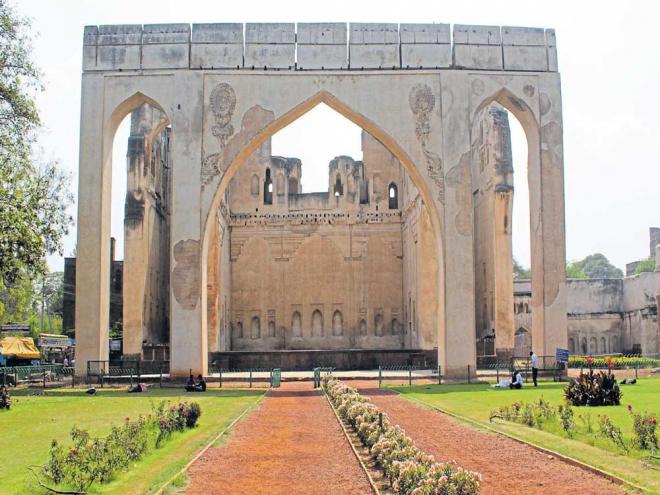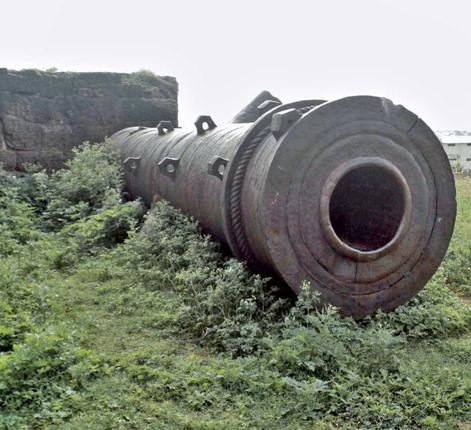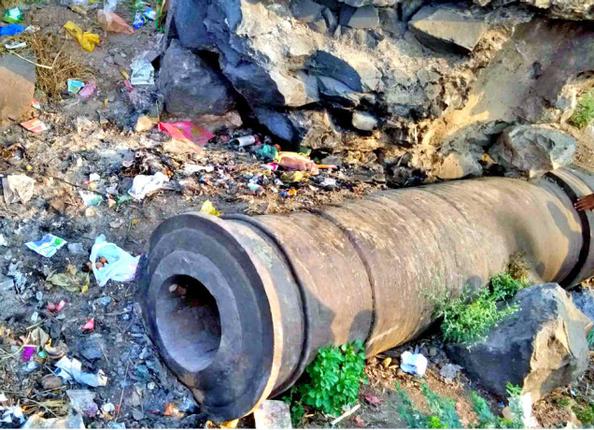Vijayapura (formerly BIJAPUR ) , KARNATAKA :

The Adil Shahis made Bijapur (now Vijayapura) a city ahead of its time in terms of infrastructure development and security. This well-planned city had two fortifications, one around the principal Adil Shahi administrative and residential buildings, and a larger one around the rest of the city. Both were roughly circular and had moats and several gateways. To further strengthen the defence of the city walls, the Adil Shahis built many bastions and about 96 gigantic cannons were placed on them. Only a dozen of these canons exist today. Most of them are placed in the Archaeological Survey of India (ASI) museum housed in the Nagaad Khana in front of Gol Gumbaz and some of them still sit atop the surviving bastions.
First line of defence
The fortifications have crumbled due to neglect and the moats are overgrown with thorny shrubs and in some places, they are filled with sewage and garbage. The only gateway that the citadel still has is on the south. This was the principal gateway into the citadel but now wears an abandoned look. Just inside this once splendid gateway are the remains of guardrooms constructed entirely of pillars from Hindu temples mostly belonging to the Vijayanagara period.
One of the surviving bastions is the Sharza Burj or Lion Bastion which is also the largest bastion in the city. It is famous for housing the cannon Malik-i-Maidan or Lord of the Plains, which was a war trophy won after the defeat of the Vijayanagara Empire at the Battle of Talikota. The cannon is made from a special alloy and can fire not only cannon balls but also metal slugs and copper coins.
Nearby is Haidar Burj which is the highest gun platform in Vijayapura and is a very conspicuous solitary structure.
It is also called the Upri or Upli Burj by the locals. It was built in 1583 by Haidar Khan, a general during the reigns of Ali Adil Shah I and Ibrahim Adil Shah II. A spiral stairway leads to the top which houses two long cannons. The tower was most probably customised for the guns which needed to be fired from a height so that they can have a long range.
The Adil Shahis wanted to transform their capital city to match the Mughal cities in the North by building imposing courtly structures, gardens, wells, waterways and granaries. While most of the structures have fallen to ruin, some have been converted to government offices and only a handful are open to tourists. The Gagan Mahal was built by Ali Adil Shah I as a palace and an audience hall. Only its structural skeleton remains today. A short walk from the Gagan Mahal is the Sath Manzil (Seven Pavillions) or Haft Manzil built by Ibrahim II as a pleasure pavilion. Only a few storeys survive now and there is no way to go inside. Just opposite this is Jal Mahal or Water Pavilion that has been decorated exquisitely and is crowned by a dome. It is set in the middle of a square pool which is now dry and filled with garbage. Again, there is no way to go inside.
Reservoirs & stepwells
Water was and is a precious resource for Vijayapura and the Adil Shahis built a complex hydraulic system to bring water from distant sources into the city and supplemented this with reservoirs and stepwells. Only a few stepwells and reservoirs survive today and the system of aqueducts and horizontal wells are lost. The Taj Baoli is the biggest stepwell in Vijayapura and was built by Malik Sandal, a Persian architect, in honour of Taj Sultana, the wife of Ibrahim Adil Shah II. Sadly the well, its gateway and the gallery around it are in a very bad state. It won’t survive for long if no action is taken immediately.
Another well-known stepwell present here is the Chand Baoli. The stepwell was built by Ali Adil Shah I in honour of his wife Chand Bibi and it served as the model for Taj Baoli. Chand Bibi is best known for courageously defending Ahmednagar and Bijapur against the attacks of the Mughal Emperor Akbar. She was the regent of both Ahmednagar and Bijapur and was known to be a good warrior, musician, linguist and artist. The structure is now completely cordoned off from the public. One can only see it through the grill gate.
Present-day Vijayapura would have benefited if the administration had preserved the hydraulic system of the Adil Shahis and used the many stepwells and reservoirs instead of letting them turn into garbage dumps. Waking up to this, the Minister for Water Resources, M B Patil announced in April that starting with Taj Baoli, around 20 wells in Vijayapura will be rejuvenated at the cost of Rs 4.25 crore. As a part of the rejuvenation process, the dirty water present in the wells is being pumped out, the garbage is being removed, and the well is being desilted. Additionally, there are plans to repair the structures around them. When fresh water accumulates, it will be pumped and stored in tanks, from which people can collect water for domestic purposes apart from drinking. This will ease the water scarcity the city is facing to a certain extent.
Unless people surrounding these monuments understand their historical importance and realise that a clean baoli can help face water scarcity, all efforts to revive the heritage structures will be futile.
source: http://www.deccanherald.com / Deccan Herald / Home> Supplements> Spectrum / by Rijutha Jagannathan / July 04th, 2017










